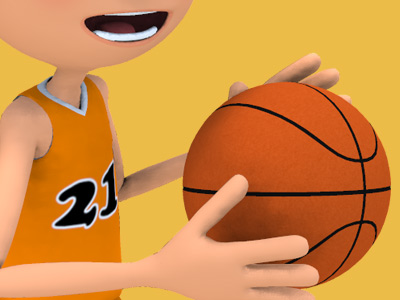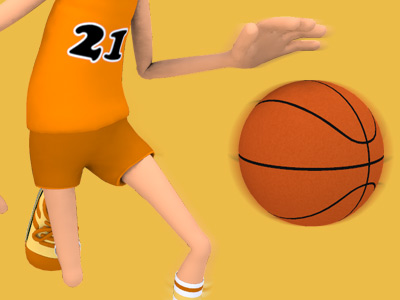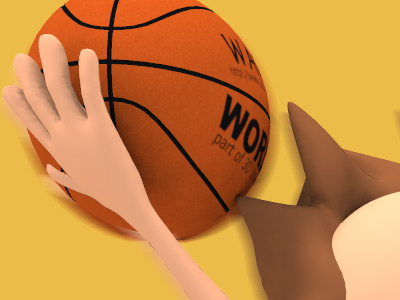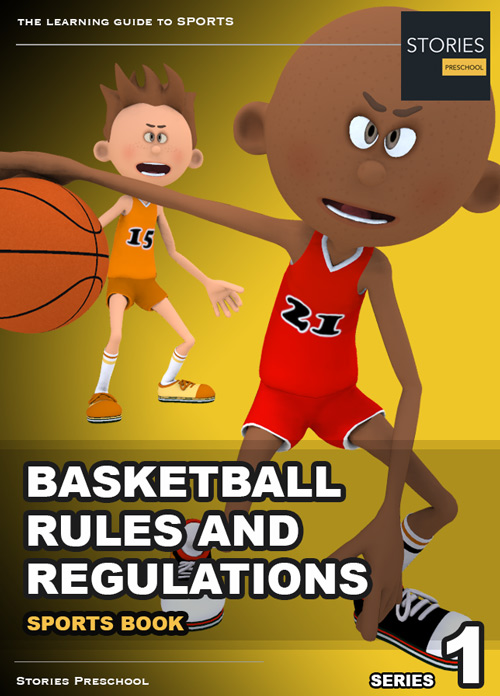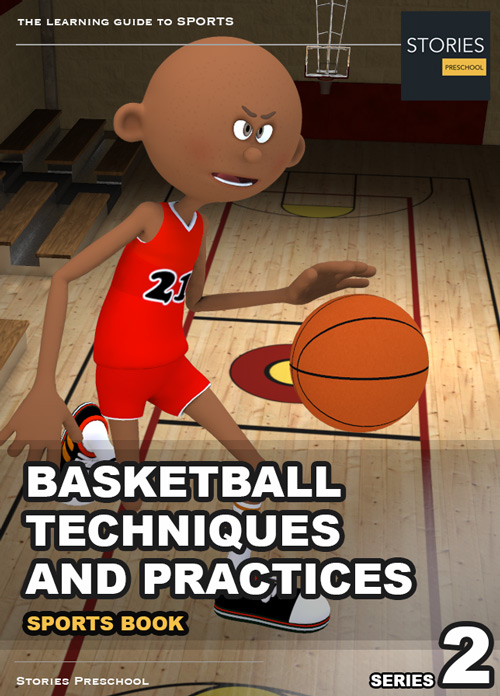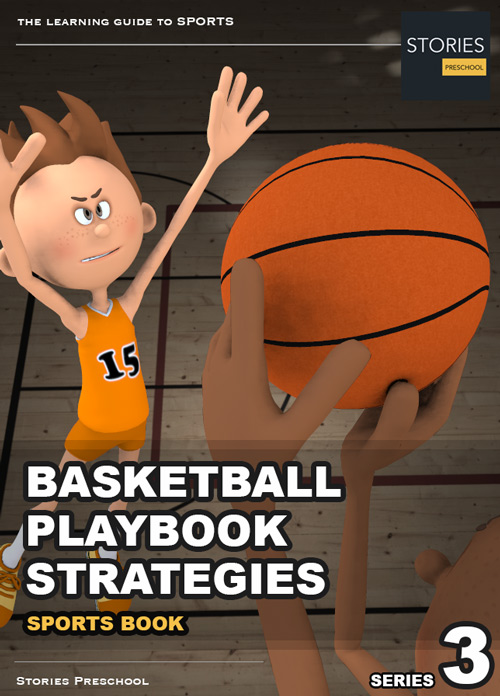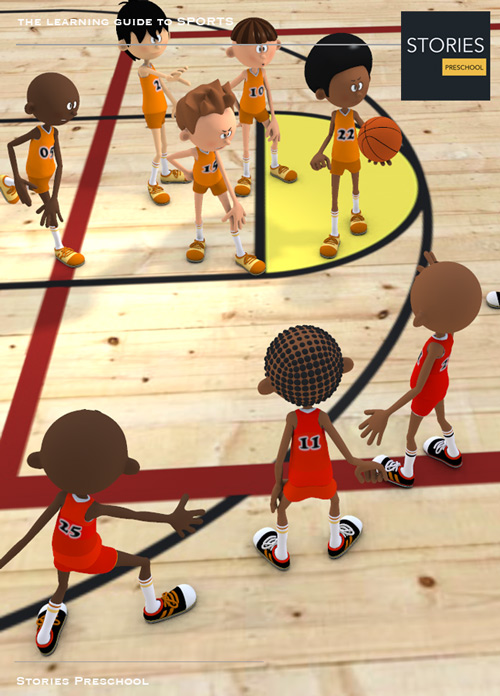Basketball

Basketball
Basketball is a sport played by two teams of five players on a rectangular court. The objective is to shoot a ball through a hoop 18 inches (46 cm) in diameter and 10 feet (3.048 m) high mounted to a backboard at each end.
A team can score a field goal by shooting the ball through the basket during regular play. A field goal scores three points for the shooting team if the player shoots from behind the three-point line, and two points if shot from in front of the line. A team can also score via free throws, which are worth one point, after the other team was assessed with certain fouls. The team with the most points at the end of the game wins, but additional time (overtime) is issued when the score is tied at the end of regulation. The ball can be advanced on the court by throwing it to a teammate, or by bouncing it while walking or running (dribbling). It is a violation to lift, or drag, one's pivot foot without dribbling the ball, to carry it, or to hold the ball with both hands then resume dribbling.
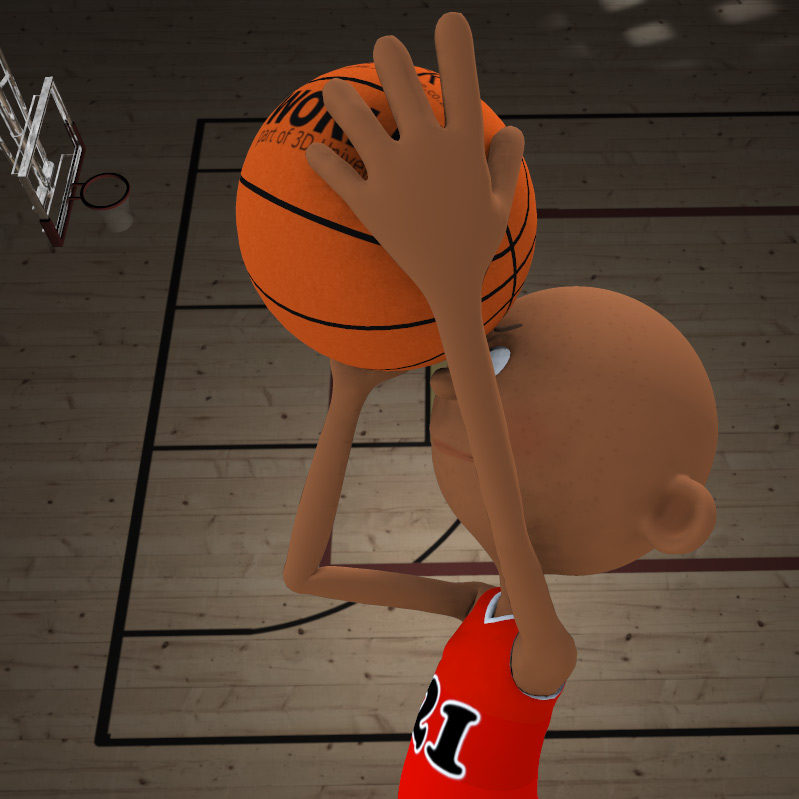
There are many techniques for ball handling—shooting, passing, dribbling, and rebounding. Basketball teams generally have player positions, the tallest and strongest members of a team are called a center or power forward, while slightly shorter and more agile players are called small forward, and the shortest players or those who possess the best ball handling skills are called a point guard or shooting guard. The point guard directs the on court action of the team, implementing the coach's game plan, and managing the execution of offensive and defensive plays (player positioning).
History
In early December 1891, Canadian Dr. James Naismith, a physical education professor and instructor at the International Young Men's Christian Association Training School (YMCA) (today, Springfield College) in Springfield, Massachusetts was trying to keep his gym class active on a rainy day. He sought a vigorous indoor game to keep his students occupied and at proper levels of fitness during the long New England winters. After rejecting other ideas as either too rough or poorly suited to walled-in gymnasiums, he wrote the basic rules and nailed a peach basket onto a 10-foot (3.05 m) elevated track. In contrast with modern basketball nets, this peach basket retained its bottom, and balls had to be retrieved manually after each "basket" or point scored; this proved inefficient, however, so the bottom of the basket was removed, allowing the balls to be poked out with a long dowel each time.
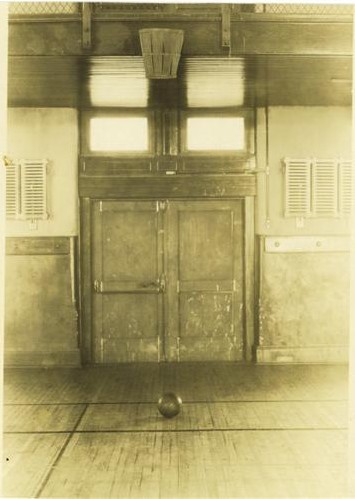
Basketball was originally played with a soccer ball. The first balls made specifically for basketball were brown, and it was only in the late 1950s that Tony Hinkle, searching for a ball that would be more visible to players and spectators alike, introduced the orange ball that is now in common use. Dribbling was not part of the original game except for the "bounce pass" to teammates. Passing the ball was the primary means of ball movement. Dribbling was eventually introduced but limited by the asymmetric shape of early balls. Dribbling only became a major part of the game around the 1950s, as manufacturing improved the ball shape.
The peach baskets were used until 1906 when they were finally replaced by metal hoops with backboards. A further change was soon made, so the ball merely passed through. Whenever a person got the ball in the basket, his team would gain a point. Whichever team got the most points won the game. The baskets were originally nailed to the mezzanine balcony of the playing court, but this proved impractical when spectators in the balcony began to interfere with shots. The backboard was introduced to prevent this interference; it had the additional effect of allowing rebound shots. Naismith's handwritten diaries, discovered by his granddaughter in early 2006, indicate that he was nervous about the new game he had invented, which incorporated rules from a children's game called "Duck on a Rock", as many had failed before it. Naismith called the new game "Basket Ball". The first official game was played in the YMCA gymnasium in Albany, New York, on January 20, 1892, with nine players. The game ended at 1–0; the shot was made from 25 feet (7.6 m), on a court just half the size of a present-day Streetball or National Basketball Association (NBA) court. By 1897–1898 teams of five became standard.
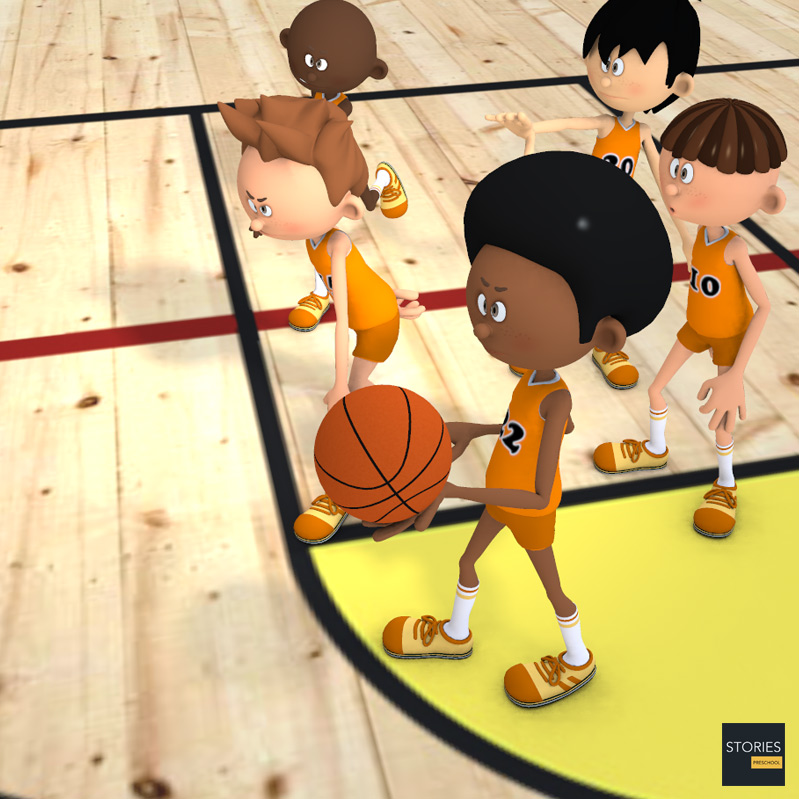
College Basketball
Basketball's early adherents were dispatched to YMCAs throughout the United States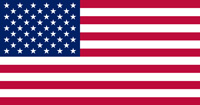 The United States of America (U.S.A. or USA), commonly known as the United States (U.S. or US) or America, is a country in North America. It is the world's third-largest country by both land and total area. The United States shares land borders with Canada to its north and with Mexico to its south. The national capital is Washington, D.C., and the most populous city and financial center is New York City., and it quickly spread through the USA and Canada. By 1895, it was well established at several women's high schools. While the YMCA was responsible for initially developing and spreading the game, within a decade it discouraged the new sport, as rough play and rowdy crowds began to detract from the YMCA's primary mission. However, other amateur sports clubs, colleges, and professional clubs quickly filled the void. In the years before World War I
The United States of America (U.S.A. or USA), commonly known as the United States (U.S. or US) or America, is a country in North America. It is the world's third-largest country by both land and total area. The United States shares land borders with Canada to its north and with Mexico to its south. The national capital is Washington, D.C., and the most populous city and financial center is New York City., and it quickly spread through the USA and Canada. By 1895, it was well established at several women's high schools. While the YMCA was responsible for initially developing and spreading the game, within a decade it discouraged the new sport, as rough play and rowdy crowds began to detract from the YMCA's primary mission. However, other amateur sports clubs, colleges, and professional clubs quickly filled the void. In the years before World War I World War I, also known as the First World War, or the Great War, was a global war originating in Europe that lasted from 28 July 1914 to 11 November 1918. More than 70 million military personnel, including 60 million Europeans, were mobilized in one of the largest wars in history. The war drew in all the world's economic great powers, assembled in two opposing alliances: the Allies versus the Central Powers of Germany and Austria-Hungary. View World War I », the Amateur Athletic Union and the Intercollegiate Athletic Association of the United States (forerunner of the NCAA) vied for control over the rules for the game. The first pro league, the National Basketball League, was formed in 1898 to protect players from exploitation and to promote a less rough game. This league only lasted five years.
World War I, also known as the First World War, or the Great War, was a global war originating in Europe that lasted from 28 July 1914 to 11 November 1918. More than 70 million military personnel, including 60 million Europeans, were mobilized in one of the largest wars in history. The war drew in all the world's economic great powers, assembled in two opposing alliances: the Allies versus the Central Powers of Germany and Austria-Hungary. View World War I », the Amateur Athletic Union and the Intercollegiate Athletic Association of the United States (forerunner of the NCAA) vied for control over the rules for the game. The first pro league, the National Basketball League, was formed in 1898 to protect players from exploitation and to promote a less rough game. This league only lasted five years.
Dr. James Naismith was instrumental in establishing college basketball. His colleague C.O. Beamis fielded the first college basketball team just a year after the Springfield YMCA game at the suburban Pittsburgh Geneva College. Naismith himself later coached at the University of Kansas for six years, before handing the reins to renowned coach Forrest "Phog" Allen. Naismith's disciple Amos Alonzo Stagg brought basketball to the University of Chicago, while Adolph Rupp, a student of Naismith's at Kansas, enjoyed great success as coach at the University of Kentucky. On February 9, 1895, the first intercollegiate 5-on-5 game was played at Hamline University between Hamline and the School of Agriculture, which was affiliated with the University of Minnesota. The School of Agriculture won in a 9–3 game.
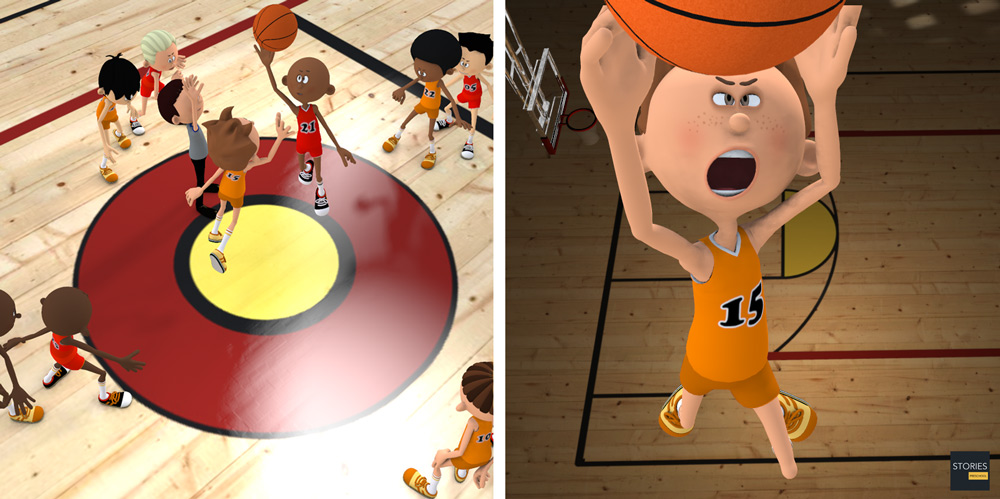
In 1901, colleges, including the University of Chicago, Columbia University, Cornell University, Dartmouth College, the University of Minnesota, the U.S. Naval Academy, the University of Colorado and Yale University began sponsoring men's games. In 1905, frequent injuries on the football field prompted President Theodore Roosevelt to suggest that colleges form a governing body, resulting in the creation of the Intercollegiate Athletic Association of the United States (IAAUS). In 1910, that body would change its name to the National Collegiate Athletic Association (NCAA). The first Canadian interuniversity basketball game was played at the YMCA in Kingston, Ontario on February 6, 1904, when McGill University visited Queen's University. McGill won 9–7 in overtime; the score was 7–7 at the end of regulation play, and a ten-minute overtime period settled the outcome. A good turnout of spectators watched the game.
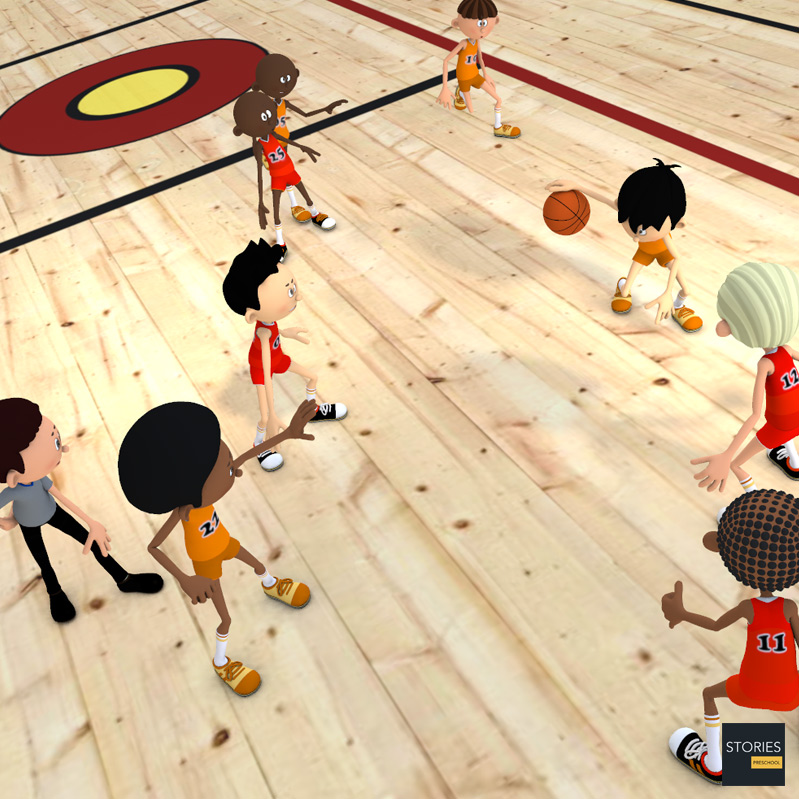
The first men's national championship tournament, the National Association of Intercollegiate Basketball tournament, which still exists as the National Association of Intercollegiate Athletics (NAIA) tournament, was organized in 1937. The first national championship for NCAA teams, the National Invitation Tournament (NIT) in New York, was organized in 1938; the NCAA national tournament would begin one year later. College basketball was rocked by gambling scandals from 1948 to 1951, when dozens of players from top teams were implicated in match fixing and point shaving. Partially spurred by an association with cheating, the NIT lost support to the NCAA tournament.
High School Basketball
Before widespread school district consolidation, most American high schools were far smaller than their present-day counterparts. During the first decades of the 20th century, basketball quickly became the ideal interscholastic sport due to its modest equipment and personnel requirements. In the days before widespread television coverage of professional and college sports, the popularity of high school basketball was unrivaled in many parts of America. Perhaps the most legendary of high school teams was Indiana's Franklin Wonder Five, which took the nation by storm during the 1920s, dominating Indiana basketball and earning national recognition.
Today virtually every high school in the United States fields a basketball team in varsity competition. Basketball's popularity remains high, both in rural areas where they carry the identification of the entire community, as well as at some larger schools known for their basketball teams where many players go on to participate at higher levels of competition after graduation. In the 2003–04 season, 1,002,797 boys and girls represented their schools in interscholastic basketball competition, according to the National Federation of State High School Associations. The states of Illinois, Indiana and Kentucky are particularly well known for their residents' devotion to high school basketball, commonly called Hoosier Hysteria in Indiana; the critically acclaimed film Hoosiers shows high school basketball's depth of meaning to these communities.
There is currently no tournament to determine a national high school champion. The most serious effort was the National Interscholastic Basketball Tournament at the University of Chicago from 1917 to 1930. The event was organized by Amos Alonzo Stagg and sent invitations to state champion teams. The tournament started out as a mostly Midwest affair but grew. In 1929 it had 29 state champions. Faced with opposition from the National Federation of State High School Associations and North Central Association of Colleges and Schools that bore a threat of the schools losing their accreditation the last tournament was in 1930. The organizations said they were concerned that the tournament was being used to recruit professional players from the prep ranks. The tournament did not invite minority schools or private/parochial schools.
The National Catholic Interscholastic Basketball Tournament ran from 1924 to 1941 at Loyola University. The National Catholic Invitational Basketball Tournament from 1954 to 1978 played at a series of venues, including Catholic University, Georgetown and George Mason. The National Interscholastic Basketball Tournament for Black High Schools was held from 1929 to 1942 at Hampton Institute. The National Invitational Interscholastic Basketball Tournament was held from 1941 to 1967 starting out at Tuskegee Institute. Following a pause during World War II it resumed at Tennessee State College in Nashville. The basis for the champion dwindled after 1954 when Brown v. Board of Education began an integration of schools. The last tournaments were held at Alabama State College from 1964 to 1967.
Professional Basketball
Teams abounded throughout the 1920s. There were hundreds of men's professional basketball teams in towns and cities all over the United States, and little organization of the professional game. Players jumped from team to team and teams played in armories and smoky dance halls. Leagues came and went. Barnstorming squads such as the Original Celtics and two all-African American teams, the New York Renaissance Five ("Rens") and the (still existing) Harlem Globetrotters played up to two hundred games a year on their national tours.
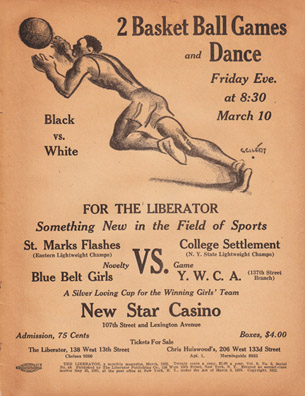
In 1946, the Basketball Association of America (BAA) was formed. The first game was played in Toronto, Ontario, Canada between the Toronto Huskies and New York Knickerbockers on November 1, 1946. Three seasons later, in 1949, the BAA merged with the National Basketball League to form the National Basketball Association (NBA). By the 1950s, basketball had become a major college sport, thus paving the way for a growth of interest in professional basketball. In 1959, a basketball hall of fame was founded in Springfield, Massachusetts, site of the first game. Its rosters include the names of great players, coaches, referees and people who have contributed significantly to the development of the game. The hall of fame has people who have accomplished many goals in their career in basketball. An upstart organization, the American Basketball Association, emerged in 1967 and briefly threatened the NBA's dominance until the ABA-NBA merger in 1976. Today the NBA is the top professional basketball league in the world in terms of popularity, salaries, talent, and level of competition.
The NBA has featured many famous players, including George Mikan, the first dominating "big man"; ball-handling wizard Bob Cousy and defensive genius Bill Russell of the Boston Celtics; charismatic center Wilt Chamberlain, who originally played for the barnstorming Harlem Globetrotters; all-around stars Oscar Robertson and Jerry West; more recent big men Kareem Abdul-Jabbar, Shaquille O'Neal, Hakeem Olajuwon and Karl Malone; playmakers John Stockton, Isiah Thomas and Steve Nash; crowd-pleasing forwards Julius Erving and Charles Barkley; European stars Dirk Nowitzki, Pau Gasol and Tony Parker; more recent superstars LeBron James, Allen Iverson and Kobe Bryant; and the three players who many credit with ushering the professional game to its highest level of popularity during the 1980s and 1990s: Larry Bird, Earvin "Magic" Johnson, and Michael Jordan.
In 2001, the NBA formed a developmental league, the NBA Development League (also known as the D-League). As of the 2016–17 season, the D-League has 22 teams.
SPORTS
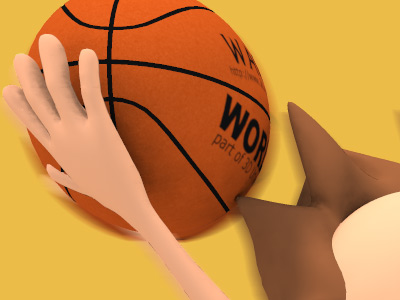
RESOURCES
This article uses material from the Wikipedia article "Basketball", which is released under the Creative Commons Attribution-Share-Alike License 3.0.
© Stories Preschool. All Rights Reserved.
